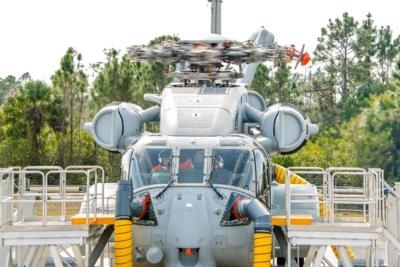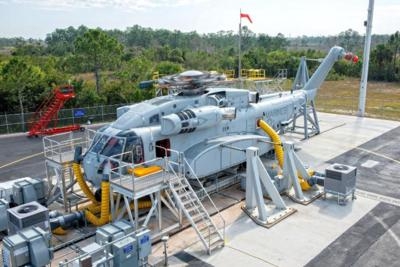Four Additional Aircraft Being Prepared For Flight Testing This Year
Sikorsky has powered up the engines and spun the rotor head on the first prototype CH-53K heavy lift helicopter designated the Ground Test Vehicle (GTV). The January 24 event continues the "Bare Head Light Off" phase of testing ... so named because it was conducted without rotor blades ... that began under auxiliary power in December with safety-of-flight test pilots at the aircraft's controls.

"GTV main engines powered 'on' is a significant step for the CH-53K helicopter program," said Mike Torok, Sikorsky's CH-53K Program Vice President. "Having independently tested the aircraft's many components and subsystems, including electrical and avionics, hydraulics and flight controls, landing gear, propulsion, transmissions and rotors, now we have begun testing these critical functions as an entire system powered by the GTV aircraft's three GE 7,500 shaft horsepower class engines."
Sikorsky delivered the GTV into the test program at the company's West Palm Beach, Fla.-based Development Flight Center in late 2012. Now anchored to the ground at its remote outdoor test site, the 44,000-pound GTV aircraft is outfitted at more than 1,300 points with sensors that will measure and verify the ability to operate safely under its own power. The GTV will undergo ground testing for approximately two years with both Sikorsky and U.S. Marine Corps test pilots at the controls.
Once Bare Head testing is completed, Sikorsky will mount seven main rotor blades and four tail rotor blades onto the GTV. During this second test phase, Sikorsky will conduct extensive aircraft system checks leading to a formal Pre-Flight Acceptance Test required to clear the first flight aircraft for flight testing.
Four additional test aircraft are being prepared for flight test, commencing in late 2014. During the three-year flight test program, Sikorsky will continue to evaluate the GTV for long-term endurance of the engines and dynamic components, survivability, and maintenance practices.

"We have entered a much anticipated phase in this developmental program," said Col. Robert Pridgen, U.S. Marine Corps Program Manager for Heavy Lift Helicopters. "We have experienced significant learning at the sub-system and component level, which continues to build our confidence in the capabilities of the 53K. We look forward to the initial validation and discovery at a full system level."
Sikorsky leads an industry team developing the CH-53K heavy lift helicopter for the U.S. Marine Corps. The aircraft's 88,000-pound maximum gross weight is designed to triple the external load carrying capacity of the CH-53E Super Stallion aircraft to more than 27,000 pounds over a mission radius of 110 nautical miles under "high hot" ambient conditions.
The U.S. Department of Defense's Program of Record remains at 200 CH-53K aircraft with a U.S. Marine Corps Initial Operational Capability in 2019. Eventual production quantities would be determined year-by-year over the life of the program based on funding allocations set by Congress and the U.S. Department of Defense acquisition priorities. The Marine Corps intends to stand up eight active duty squadrons, one training squadron, and one reserve squadron to support operational requirements.
(Images provided by Sikorsky)
 ANN's Daily Aero-Term (04.26.24): DETRESFA (Distress Phrase)
ANN's Daily Aero-Term (04.26.24): DETRESFA (Distress Phrase) Aero-News: Quote of the Day (04.26.24)
Aero-News: Quote of the Day (04.26.24) ANN's Daily Aero-Term (04.27.24): Direct
ANN's Daily Aero-Term (04.27.24): Direct ANN's Daily Aero-Linx (04.27.24)
ANN's Daily Aero-Linx (04.27.24) Aero-News: Quote of the Day (04.27.24)
Aero-News: Quote of the Day (04.27.24)




